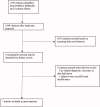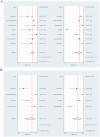Diagnostic value of procalcitonin for bacterial infections in patients undergoing hemodialysis: a systematic review and meta-analysis
- PMID: 35164633
- PMCID: PMC8856046
- DOI: 10.1080/0886022X.2021.2021236
Diagnostic value of procalcitonin for bacterial infections in patients undergoing hemodialysis: a systematic review and meta-analysis
Abstract
Background: The diagnostic value of procalcitonin (PCT) in patients undergoing hemodialysis (HD) remains unclear.
Methods: We searched multiple databases (PubMed, EMBASE, and Cochrane Library) for studies published through August 2021 that evaluated the diagnostic performance of PCT in patients undergoing HD and having suspected bacterial infections. The bivariate fixed effects model was used to calculate pooled sensitivity, specificity, diagnostic odds ratio (DOR), positive likelihood ratio (PLR), negative likelihood ratio (NLR), and summary receiver operating characteristic (SROC) curves.
Results: We identified a total of 1799 studies, of which seven diagnostic studies comprised 1444 patients and 430 bacterial infection episodes. Bivariate pooled sensitivity and specificity for PCT were 0.90 (95% CI: 0.85-0.94) and 0.83 (95% CI: 0.56-0.95), respectively. Furthermore, pooled DOR, PLR, NLR, and area under the curve (AUC) were 47 (95% CI: 11-209), 5.4 (95% CI: 1.7-16.9), 0.12 (95% CI: 0.07-0.20), and 0.92 (95% CI: 0.90-0.94), respectively. We also compared the diagnostic accuracy of PCT and C-reactive protein (CRP), and our results showed that the diagnostic accuracy parameters for PCT were significantly higher than those for CRP.
Conclusions: PCT is a useful marker for diagnosis of bacterial infections in patients undergoing HD at a cutoff value of 1.5 ng/ml.
Keywords: C-reactive protein; Procalcitonin; bacterial infections; renal dialysis; sensitivity and specificity.
Conflict of interest statement
No potential conflict of interest was reported by the authors.
Figures







References
-
- Arulkumaran N, Montero RM, Singer M.. Management of the dialysis patient in general intensive care. Br J Anaesth. 2012;108(2):183–192. - PubMed
-
- Panichi V, Migliori M, De Pietro S, et al. . C reactive protein in patients with chronic renal diseases. Ren Fail. 2001;23(3–4):551–562. - PubMed
-
- Panichi V, Migliori M, De Pietro S, et al. . C-reactive protein as a marker of chronic inflammation in uremic patients. Blood Purif. 2000;18(3):183–190. - PubMed
-
- Sitter T, Schmidt M, Schneider S, et al. . Differential diagnosis of bacterial infection and inflammatory response in kidney diseases using procalcitonin. J Nephrol. 2002;15(3):297–301. - PubMed
-
- Steinbach G, Bölke E, Grünert A, et al. . Procalcitonin in patients with acute and chronic renal insufficiency. Wien Klin Wochenschr. 2004;116(24):849–853. - PubMed
Publication types
MeSH terms
Substances
LinkOut - more resources
Full Text Sources
Medical
Research Materials
Miscellaneous
